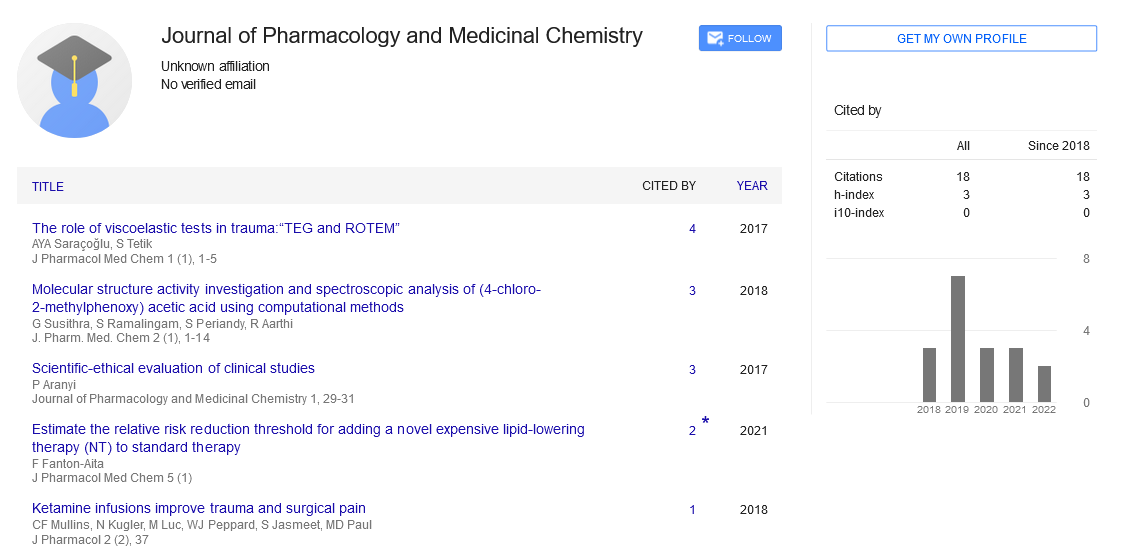Special issue for biomedical, medicinal, and pharmaceutical chemistry: A view beyond chemistry and medicine
Received: 09-Oct-2017 Accepted Date: Oct 09, 2017; Published: 12-Oct-2017
Citation: Ren Y. Special issue for biomedical, medicinal, and pharmaceutical chemistry: A view beyond chemistry and medicine. J Pharmacol Med Chem. 2017;1(1):10.
This open-access article is distributed under the terms of the Creative Commons Attribution Non-Commercial License (CC BY-NC) (http://creativecommons.org/licenses/by-nc/4.0/), which permits reuse, distribution and reproduction of the article, provided that the original work is properly cited and the reuse is restricted to noncommercial purposes. For commercial reuse, contact reprints@pulsus.com
Editorial
This special issue for “Biomedical, Medicinal, and Pharmaceutical Chemistry” of Journal of Pharmacology and Medicinal Chemistry shows readers a diverse view of chemistry and medicine, with a collection of research papers, reviews, case reports, short communications, and other types of scientific articles. The Editor would like to thank the authors for their various contributions to this issue, which reflect the recent progresses in the field of medicinal and pharmaceutical chemistry research and beyond.
Drugs, most often are small synthetic compounds or natural products used over human history to improve human life by the treatment of diseases, with medicinal and pharmaceutical chemistry, the intersection of chemistry and pharmacology, played a critical role in drug design, discovery, and development. Traditionally, these therapeutic agents have been developed from the promising leads discovered from medicinal herbs. For example, digoxin, a cardiac glycoside isolated originally from Digitalis lanata Ehrh. (Plantaginaceae) in 1930 [1] and then developed as an agent to treat clinically congestive heart failure, taxol (paclitaxel), a diterpene alkaloid characterized from Taxus brevifolia (Taxaceae) in 1971 for the first time [2] and approved in 1993 for the treatment of several types of cancer, and artemisinin, a sesquiterpene lactone identified originally from Artemisia annua L. (Asteraceae) [3] in 1977 and used long for the treatment of malaria, are important drugs developed from plant derived natural products. These agents, along with other naturally occurring compounds, have been proved to continue being an important source for new drug discovery (4). As an indicative, the 2015 Nobel Prize in Physiology or Medicine was shared by Professor Youyou Tu for her discoveries of artemisinin-related therapy against malaria [5].
However, several critical problems, including insufficient effectiveness, serious adverse effects, and the development of multidrug resistance, are observed in current chemotherapy clinics. Fortunately, synthetic modifications on leads, pro-drugs, and or drugs in enhancing their therapeutic value through optimization of pharmacokinetics, stability, potency, and/or selectivity have been proved to be promising to resolve these problems. Recently, drug repurposing and the computer-aided drug design in close combination with chemical biology, enzymology, and structural biology make a great progress in discovery and development of new therapeutic agents, with strong supports provided from metabolomics and protein‒protein interaction investigations.
In addition, pharmaceutical chemistry studies, which focus on quality issue of medication to assure a correct response to drug treatment, provide the information about the safety and efficacy of therapeutic agents after a pharmaceutical formulation process, the bioavailability, and the metabolisms. The target of these studies is to improve the drug efficacy, and, undoubtedly, the personal and target chemotherapy will become true in the near future, by using several new technologies, such as nanotechnology, DNA and RNA techniques, antibody or other types of drug conjugates, and 3-D cell culture methods.
Collectively, this special issue provides us an opportunity for publishing innovative medicinal and pharmaceutical chemistry studies, from theoretical investigations to experimental applications. We hope that it will not only highlight recent progress made in the field but also stimulate an increasing interest for new drug discovery.
REFERENCES
- Smith S. Digoxin A new digitalis glucoside. J Chem Soc. 1930;1:508-10.
- Wani MC, Taylor HL, Wall ME, et al. Plant antitumor agents. VI. The isolation and structure of taxol, a novel antileukemic and antitumor agent from Taxus brevifolia. J Am Chem Soc. 1971;93:2325-7.
- Coordinating Group for Research on the Structure of Qing Hau Sau. A new type of sesquiterpene lactone - Qing Hau Sau. Kexue Tongbao. 1977;22:142.
- Kinghorn AD, Carcache De Blanco EJ, Lucas DM, et al. Discovery of anticancer agents of diverse natural origin. Anticancer Res. 2016;36:5623-37.
- http://www.nobelprize.org/nobel_prizes/medicine/laureates/2015/press.html





